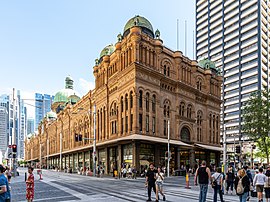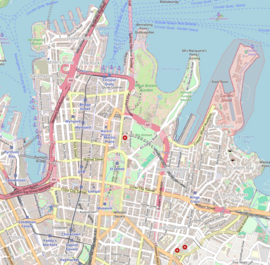| Queen Victoria Building | |
|---|---|
 The Queen Victoria Building, as viewed from George Street | |
Location in the Sydney central business district | |
| Alternative names | QVB |
| Etymology | Queen Victoria |
| General information | |
| Type |
|
| Architectural style | Romanesque revival |
| Location | 429–481 George Street, Sydney, New South Wales |
| Country | Australia |
| Coordinates | 33°52′18″S 151°12′24″E / 33.871758°S 151.206666°E |
| Current tenants | Various |
| Groundbreaking | December 1893 (Foundation stone) |
| Construction started | 1893 |
| Completed | 1898 |
| Opened |
|
| Renovated |
|
| Renovation cost | A$48 million (2006) |
| Client | Council of the City of Sydney |
| Owner | Vicinity Centres, Link REIT |
| Technical details | |
| Material | Sydney sandstone clad walls, brick and concrete, steel roof structure with concrete and fibreglass domes painted to look like concrete |
| Floor count | Four, including basement |
| Design and construction | |
| Architect(s) | George McRae |
| Structural engineer | George Massey |
| Other designers | William Priestly MacIntosh |
| Main contractor | Edwin & Henry Phippard |
| Known for | Royal Clock |
| Renovating team | |
| Architect(s) |
|
| Other designers | Freeman Rembel (2006) |
| Website | |
| www | |
| Official name | Queen Victoria Building; QVB |
| Type | State heritage (built) |
| Criteria | a., b., c., d., e., f., g. |
| Designated | 5 March 2010 |
| Reference no. | 1814 |
| Type | Market building |
| Category | Commercial |
The Queen Victoria Building (abbreviated as the QVB) is a heritage-listed late-nineteenth-century building located at 429–481 George Street in the Sydney central business district, in the state of New South Wales, Australia. Designed by the architect George McRae, the Romanesque Revival building was constructed between 1893 and 1898 and is 30 metres (98 ft) wide by 190 metres (620 ft) long. The domes were built by Ritchie Brothers, a steel and metal company that also built trains, trams and farm equipment. The building fills a city block bounded by George, Market, York, and Druitt Streets. Designed as a marketplace, it was used for a variety of other purposes, underwent remodelling, and suffered decay until its restoration and return to its original use in the late twentieth century. The property is co-owned by the City of Sydney and Link REIT,[1] and was added to the New South Wales State Heritage Register on 5 March 2010.[2]
- ^ "Queen Victoria Building". Vicinity Centres. Retrieved 11 February 2024.
- ^ "Queen Victoria Building". New South Wales State Heritage Register. Department of Planning & Environment. H01814. Retrieved 14 October 2018.
 Text is licensed by State of New South Wales (Department of Planning and Environment) under CC BY 4.0 licence.
Text is licensed by State of New South Wales (Department of Planning and Environment) under CC BY 4.0 licence.
